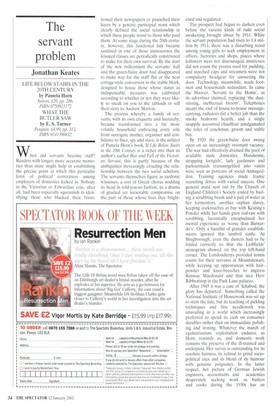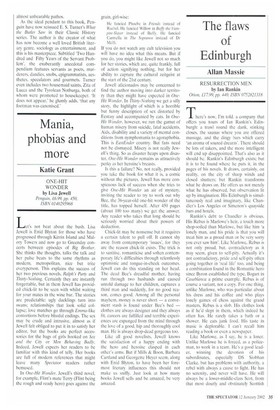The servant problem
Jonathan Keates
LIFE BELOW STAIRS IN THE 20TH CENTURY by Pamela Horn Sutton, £20, pp. 286, ISBN 0750923172 WHAT THE BUTLER SAW by E. S. Turner Penguin,14.99, pp. 312, ISBN 0141390832 When did servants become staff? Readers with longer, more accurate memories than mine might help in establishing the precise point at which this particular form of political correctness among employers of domestics kicked in. Nobody .11 the Victorian or Edwardian eras, after all, had been especially squeamish in idenifying those who blacked their boots, ironed their newspapers or paunched their hares by a generic participial noun which clearly defined the social relationship in which these people stood to those who paid them. At some stage during the 20th century, however, this functional link became sanitised in one of those manoeuvres the leisured classes are periodically constrained to make for their own survival. By the start of the new millennium the servants' hall and the green-baize door had disappeared to make way for the staff flat or the neat cottage-style conversion in the stable block, designed to house those whose status as indispensable treasures was calibrated according to whether or not they were likely to sneak on you to the tabloids or sell their story to Andrew Morton.
The process whereby a family of servants, with its own etiquette and hierarchy, became transformed into a far more volatile household embracing every role from surrogate mother, organiser and confidante to fixer, spy and slave, is the subject of Pamela Horn's book. If Life Below Stairs in the 20th Century is a richer mix than its author's earlier Rise and Fall of the Victorian Servant, this is partly because of the ambiguities increasingly clouding the relationship between the two social echelons. The servants themselves figure as sardonic witnesses, a sort of Greek chorus nodding its head in told-you-so fashion, to a drama of gradual yet inexorable compromise on the part of those whose lives they bright
ened and regulated.
The prospect had begun to darken even before the various kinds of rude social awakening brought about by 1914. While the servant population had risen to 1.4 million by 1911, there was a disturbing trend among young girls to seek employment in offices, factories and shops, places where followers were not discouraged, mistresses did not count the prunes used for pudding, and starched caps and streamers were not compulsory headgear for answering the door. Technology, meanwhile, made footmen and housemaids redundant. In came the Hoover, 'Servant to the Home', as its advertiser claimed, replacing 'the duststirring, ineffectual broom'. Telephones meant the end of house-to-house messagecarrying, radiators did a better job than the smoky bedroom hearth, and a single snappily accoutred chauffeur amalgamated the roles of coachman, groom and stable boy.
By 1920 the green-baize door swung open on an increasingly resonant vacancy. The war had effectively drained the pool of available male domestics. 'Handsome, strapping footgirls', lady gardeners and parlourmaids transmogrified into valets were seen as portents of social Armageddon. Training agencies made frantic recruiting drives with varied success. One general maid sent out by the Church of England Children's Society ended by hurling a scrubbing brush and a pail of water at her tormentors, another orphan slavey, keeping cockroaches at bay with Keating's Powder while her hands grew red-raw with scrubbing, laconically encapsulated her menial experience as 'worse than Barnardo's'. Only a handful of grander establishments ignored this tumbril rattle. At Shugborough, even the dusters had to be folded correctly so that the Lichfields' monogram showed on the top left-hand corner. The Londonderrys provided tennis courts for their servants at Mountstevvart, while keeping up appearances with hairpowder and knee-breeches to impress Ramsay Macdonald and that nice Herr Ribbentrop in the Park Lane palazzo.
After 1945 it was a case of Ichabod, the glory has departed'. Something called the National Institute of Housework was set up to stem the tide, but its teaching of pickling techniques and fine needlework was unavailing in a world which increasingly preferred to spend its cash on consumer durables rather than on immaculate polishing and ironing. Whatever the march of egalitarianism, exploitation endures, as Horn reminds us, and domestic work remains the preserve of the ill-trained and underpaid. Her survey is outstanding for its resolute fairness, its refusal to grind sociopolitical axes and its blend of sly humour with genuine poignancy. In the latter respect, her picture of German Jewish engineers, accountants and academics desperately seeking work as butlers and cooks during the 1930s has an almost unbearable pathos.
As the ideal pendant to this book, Penguin have now reissued E. S. Turner's What the Butler Saw in their Classic History series. The author is the creator of what has now become a well loved British literary genre, sociology as entertainment, and this is his masterpiece. Subtitled 'Two Hundred and Fifty Years of the Servant Problem', the exuberantly anecdotal compendium features servants as poets, murderers, dandies, snobs, epigrammatists, aesthetes, speculators and gourmets. Turner even includes two housemaid saints, Zita of Lucca and the Tyrolean Notburga, both of whom were promoted to housekeeper. It does not appear.' he glumly adds, 'that any footman was canonised.'



























































 Previous page
Previous page